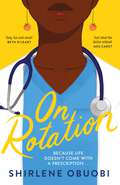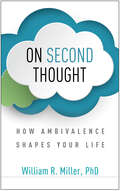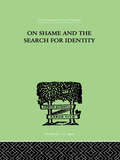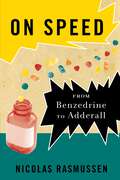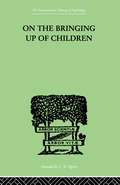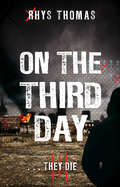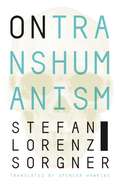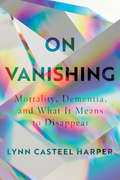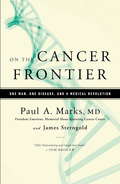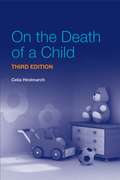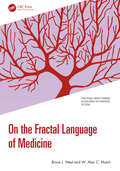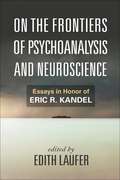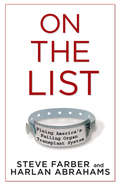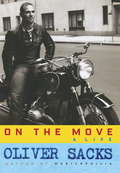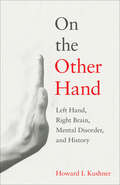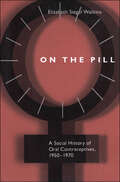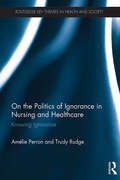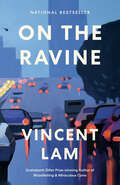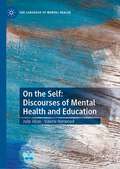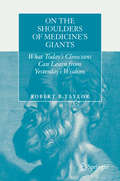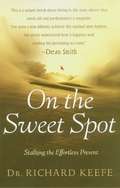- Table View
- List View
On Rotation: The perfect will-they-won't-they romance for fans of GREY'S ANATOMY and THE LOVE HYPOTHESIS
by Shirlene Obuobi'As a fan of Grey's Anatomy (and Chicago Med!), I couldn't put down On Rotation, and you won't be able to, either... I personally couldn't get enough' MEG CABOT 'A smart, fun rom-com. What I loved most about the book was the fact that the love interest was just as delightfully flawed and three-dimensional as the heroine, and that made me root for their happy ending all the more' BETH O'LEARY Ghanaian-American Angela Appiah has checked off all the boxes for the 'Perfect Immigrant Daughter': enroll in an elite medical school; snag a suitable lawyer/doctor/engineer boyfriend, and surround herself with a gaggle of successful and/or loyal friends... But when her boyfriend dumps her, her best friend pulls away, and she bombs the most important exam of her medical career, Angie finds herself in the middle of a quarter life crisis of epic proportions. To make matters worse, her parents are suddenly a lot less proud of their daughter, now that she's not following through with the path they chose for her. Just when things couldn't get any more complicated, enter Ricky Gutierrez - brilliant, thoughtful, sexy, and most importantly, seems to see Angie for who she is instead of what she can represent. Unfortunately, he's also got 'wasteman' practically tattooed across his forehead, and Angie's done chasing mirages of men. Or so she thinks... For someone who's always been in control, Angie realizes that there's one thing she can't plan on: matters of her heart.For fans of Grey's Anatomy and Seven Days in June, this dazzling debut novel by Shirlene Obuobi explores that time in your life when you must decide what you want, how to get it, and who you are, all while navigating love, friendship, and the realization that the path you're traveling is going to be a bumpy ride. 'Narrated by a strong lead with an unforgettable voice, On Rotation is an original romance novel bursting with charm, humor and the most loveable characters. I'm besotted with Angie and her posse!' LIZZIE DAMILOLA BLACKBURN, author of Yinka, Where is Your Huzband?
On Second Thought: How Ambivalence Shapes Your Life
by William R. MillerThe rich inner world of a human being is far more complex than either/or. You can love and hate, want to go and want to stay, feel both joy and sadness. Psychologist William Miller--one of the world's leading experts on the science of change--offers a fresh perspective on ambivalence and its transformative potential in this revealing book. Rather than trying to overcome indecision by force of will, Dr. Miller explores what happens when people allow opposing arguments from their &“inner committee members&” to converse freely with each other. Learning to tolerate and even welcome feelings of ambivalence can help you get unstuck from unwanted habits, clarify your desires and values, explore the pros and cons of tough decisions, and open doorways to change. Vivid examples from everyday life, literature, and history illustrate why we are so often "of two minds," and how to work through it.
On Shame And The Search For Identity
by Lynd, Helen MerrellFirst published in 1999. Routledge is an imprint of Taylor & Francis, an informa company.
On Speed: From Benzedrine to Adderall
by Nicolas RasmussenAn extensively researched account of the ups and downs in the history of uppers Uppers. Crank. Bennies. Dexies. Greenies. Black Beauties. Purple Hearts. Crystal. Ice. And, of course, Speed. Whatever their street names at the moment, amphetamines have been an insistent force in American life since they were marketed as the original antidepressants in the 1930s. On Speed tells the remarkable story of their rise, their fall, and their surprising resurgence. Along the way, it discusses the influence of pharmaceutical marketing on medicine, the evolving scientific understanding of how the human brain works, the role of drugs in maintaining the social order, and the centrality of pills in American life. Above all, however, this is a highly readable biography of a very popular drug. And it is a riveting story. Incorporating extensive new research, On Speed describes the ups and downs (fittingly, there are mostly ups) in the history of amphetamines, and their remarkable pervasiveness. For example, at the same time that amphetamines were becoming part of the diet of many GIs in World War II, an amphetamine-abusing counterculture began to flourish among civilians. In the 1950s, psychiatrists and family doctors alike prescribed amphetamines for a wide variety of ailments, from mental disorders to obesity to emotional distress. By the late 1960s, speed had become a fixture in everyday life: up to ten percent of Americans were thought to be using amphetamines at least occasionally.Although their use was regulated in the 1970s, it didn't take long for amphetamines to make a major comeback, with the discovery of Attention Deficit Disorder and the role that one drug in the amphetamine family—Ritalin—could play in treating it. Today’s most popular diet-assistance drugs differ little from the diet pills of years gone by, still speed at their core. And some of our most popular recreational drugs—including the "mellow" drug, Ecstasy—are also amphetamines. Whether we want to admit it or not, writes Rasmussen, we’re still a nation on speed.
On The Bringing Up Of Children (International Library Of Psychology Ser.)
by Rickman, JohnFirst Published in 1999. Routledge is an imprint of Taylor & Francis, an informa company.
On The Third Day
by Rhys ThomasSociety is on the brink of collapse. The Old World is vanishing, the New World is taking over. There are no rules. Not now that a deadly disease is spreading that causes its victims to turn violent. Previously loving people become murderous. No-one can tell who will turn and who will not. A work of force and dark brilliance - the perfect expression of the terrors of the 21st Century
On Transhumanism
by Stefan Lorenz SorgnerTranshumanism is widely misunderstood, in part because the media have exaggerated current technologies and branded the movement as dangerous, leading many to believe that hybrid humans may soon walk among us and that immortality, achieved by means of mind-uploading, is imminent. In this essential and clarifying volume, Stefan Lorenz Sorgner debunks widespread myths about transhumanism and tackles the most pressing ethical issues in the debate over technologically assisted human enhancement.On Transhumanism is a vital primer on the subject, written by a world-renowned expert. In this book, Sorgner presents an overview of the movement’s history, capably summarizing the twelve pillars of transhumanist discourse and explaining the great diversity of transhumanist responses to each individual topic. He highlights the urgent ethical challenges related to the latest technological developments, inventions, and innovations and compares the unique cultural standing of transhumanism to other cultural movements, placing it within the broader context of the Enlightenment, modernity, postmodernity, and the philosophical writings of Nietzsche. Engagingly written and translated and featuring an introduction for North American readers, this comprehensive overview of the cultural and philosophical movement of transhumanism will be required reading for students of posthumanist philosophy and for general audiences interested in learning about the transhumanist movement.
On Transhumanism
by Stefan Lorenz SorgnerTranshumanism is widely misunderstood, in part because the media have exaggerated current technologies and branded the movement as dangerous, leading many to believe that hybrid humans may soon walk among us and that immortality, achieved by means of mind-uploading, is imminent. In this essential and clarifying volume, Stefan Lorenz Sorgner debunks widespread myths about transhumanism and tackles the most pressing ethical issues in the debate over technologically assisted human enhancement.On Transhumanism is a vital primer on the subject, written by a world-renowned expert. In this book, Sorgner presents an overview of the movement’s history, capably summarizing the twelve pillars of transhumanist discourse and explaining the great diversity of transhumanist responses to each individual topic. He highlights the urgent ethical challenges related to the latest technological developments, inventions, and innovations and compares the unique cultural standing of transhumanism to other cultural movements, placing it within the broader context of the Enlightenment, modernity, postmodernity, and the philosophical writings of Nietzsche. Engagingly written and translated and featuring an introduction for North American readers, this comprehensive overview of the cultural and philosophical movement of transhumanism will be required reading for students of posthumanist philosophy and for general audiences interested in learning about the transhumanist movement.
On Vanishing: Mortality, Dementia, and What It Means to Disappear
by Lynn Casteel HarperAn essential book for those coping with Alzheimer's and other cognitive disorders that “reframe[s] our understanding of dementia with sensitivity and accuracy . . . to grant better futures to our loved ones and ourselves” (Parul Sehgal, The New York Times).An estimated fifty million people in the world suffer from dementia. Diseases such as Alzheimer's erase parts of one's memory but are also often said to erase the self. People don't simply die from such diseases; they are imagined, in the clichés of our era, as vanishing in plain sight, fading away, or enduring a long goodbye. In On Vanishing, Lynn Casteel Harper, a Baptist minister and nursing home chaplain, investigates the myths and metaphors surrounding dementia and aging, addressing not only the indignities caused by the condition but also by the rhetoric surrounding it. Harper asks essential questions about the nature of our outsized fear of dementia, the stigma this fear may create, and what it might mean for us all to try to “vanish well.”Weaving together personal stories with theology, history, philosophy, literature, and science, Harper confronts our elemental fears of disappearance and death, drawing on her own experiences with people with dementia both in the American healthcare system and within her own family. In the course of unpacking her own stories and encounters—of leading a prayer group on a dementia unit; of meeting individuals dismissed as “already gone” and finding them still possessed of complex, vital inner lives; of witnessing her grandfather’s final years with Alzheimer’s and discovering her own heightened genetic risk of succumbing to the disease—Harper engages in an exploration of dementia that is unlike anything written before on the subject.A rich and startling work of nonfiction, On Vanishing reveals cognitive change as it truly is, an essential aspect of what it means to be mortal.
On the Cancer Frontier: One Man, One Disease, and a Medical Revolution
by James Sterngold Paul A. MarksIn 1950, a diagnosis of cancer was all but a death sentence. Mortality rates only got worse, and as late as 1986, an article in the New England Journal of Medicine lamented: "We are losing the war against cancer. ” Cancer is one of humankind’s oldest and most persistent enemies; it has been called the existential disease. But we are now entering a new, and more positive, phase in this long campaign. While cancer has not been cured-and a cure may elude us for a long time yet-there has been a revolution in our understanding of its nature. Years of brilliant science have revealed how this individualistic disease seizes control of the foundations of life-our genes-and produces guerrilla cells that can attack and elude treatments. Armed with those insights, scientists have been developing more effective weapons and producing better outcomes for patients. Paul A. Marks, MD, has been a leader in these efforts to finally control this devastating disease. Marks helped establish the strategy for the "war on cancer” in 1971 as a researcher and member of President Nixon’s cancer panel. As the president and chief executive officer for nineteen years at the world’s pre-eminent cancer hospital, the Memorial Sloan-Kettering Cancer Center, he was instrumental in ending the years of futility. He also developed better therapies that promise a new era of cancer containment. Some cancers, like childhood leukemia and non-Hodgkin’s lymphoma, that were once deadly conditions, are now survivable-even curable. New steps in prevention and early diagnosis are giving patients even more hope. On the Cancer Frontier is Marks’ account of the transformation in our understanding of cancer and why there is growing optimism in our ability to stop it.
On the Death of a Child
by Christine HindmarchThe death of a child - whether during or following birth, through illness, through accident, or through suicide - is one of the greatest challenges families, carers, friends, and the health and social care professionals who support them can face. This book provides professionals with practical advice, resources for further support and reading, and much-needed reassurance that whatever contact they have with the bereaved, and however inadequate they may feel to the task, they can make a difference. With revised material and an entirely new chapter reflecting recent developments in bereavement theory, the third edition of this classic text offers unique insights for professionals with varying levels of experience. From theory and narrative come practical ideas on what to say, what to do, how to behave, how to stay humble in situations where the only real experts are the bereaved themselves, and how professionals can look after themselves in what can be particularly traumatic and upsetting circumstances.
On the Fence: The Hidden World of the Hard of Hearing
by Mark DrolsbaughAlthough Drolsbaugh is listed as author, he is actually the editor of writings by 37 individuals. They label themselves hard of hearing or hearing impaired. This is a very different population than the culturally deaf, signing community. Authors found their community in Self Help for the Hard of Hearing (SHHH), later renamed as HLAA (Hearing Loss Association of America). A bio of the authors is included at the end. They vary from childhood age to the elderly.
On the Fractal Language of Medicine (Fractional Order Thinking in Exploring the Frontiers of STEM)
by Bruce J. West W. Alan MutchOn the Fractal Language of Medicine bridges a very clear gap among the knowledge gained over the last 20 years in the physical and life sciences on network theory, organ synchronicity and communication, the understanding of fractal signatures in health and disease and the importance of fractional calculus in integrating these concepts.The authors opine that the field of medicine has not appreciated this hard-won knowledge and has suffered greatly as a result. This book addresses this perceived deficiency by introducing medical researchers, clinicians, residents, first-year medical students and members of allied fields to the work of the so-called hard sciences. It seeks to facilitate effective communication between empiricists and theorists by making interdisciplinary efforts to explain complex mathematical concepts to physicians and, equally important, to elucidate complex medical concepts to physicists or mathematicians.This book will be of great interest to medical students, professionals and academics, as well as students and researchers of applied mathematics, especially those interested in fractional calculus and fractals.
On the Frontiers of Psychoanalysis and Neuroscience: Essays in Honor of Eric R. Kandel
by Joseph Ledoux Mark Solms Edith LauferBuilding crucial bridges between psychoanalysis and the neurosciences, this compelling volume brings together prominent authorities from multiple disciplines. The volume highlights the contributions of Eric R. Kandel, whose seminal articles helped launch the fledgling field of neuropsychoanalysis. Contributors address what contemporary neuroscientific research reveals about how psychoanalytic techniques work and why they are effective. Also examined are ways in which psychoanalysis can contribute to scientific explorations of the mind. Each chapter is followed by a thoughtful response. This material was originally published as a special issue of The Psychoanalytic Review (Vol. 99, No. 4, 2012), editor, Alan J. Barnett, PhD.
On the List: Fixing America's Failing Organ Transplant System
by Steve Farber Harlan AbrahamsTwo families came together in the waiting room of a Denver hospital on May 11, 2004, to await kidney transplants for loved ones. In the first operation, Gregg Farber, 32, a real estate executive, donated a kidney to his father, Steve, a 60-year-old Denver lawyer and power broker. In the second, Guatemalan refugee and landscaper Ernesto Delaroca, also 32, donated a kidney to his sister Sandra, 19, a restaurant worker. The stories of how the Farber and Delaroca families made their separate journeys to the operating room offers insight into the hazards and inequities of a cobbled-together system that each year leaves more than 98,000 gravely ill Americans on the waiting list for a life-saving transplant. Steve Farber's experience inspired him to write On the List with Harlan Abrahams. They examine the ethical, legal, political, and economic debates over organ transplant policies, expose the gray market for transplants in Third World countries, and propose solutions to one of the world's most pressing health issues. An informative and inspiring guide to those who face transplant operations, the book is also a call to reform a system that is truly, and fatally, flawed.
On the Move
by Oliver SacksAn impassioned, tender, and joyous memoir by the author of Musicophilia and The Man Who Mistook His Wife for a Hat. When Oliver Sacks was twelve years old, a perceptive schoolmaster wrote in his report: "Sacks will go far, if he does not go too far." It is now abundantly clear that Sacks has never stopped going. From its opening pages on his youthful obsession with motorcycles and speed, On the Move is infused with his restless energy. As he recounts his experiences as a young neurologist in the early 1960s, first in California, where he struggled with drug addiction and then in New York, where he discovered a long-forgotten illness in the back wards of a chronic hospital, we see how his engagement with patients comes to define his life. With unbridled honesty and humor, Sacks shows us that the same energy that drives his physical passions--weight lifting and swimming--also drives his cerebral passions. He writes about his love affairs, both romantic and intellectual; his guilt over leaving his family to come to America; his bond with his schizophrenic brother; and the writers and scientists--Thom Gunn, A. R. Luria, W. H. Auden, Gerald M. Edelman, Francis Crick--who influenced him. On the Move is the story of a brilliantly unconventional physician and writer--and of the man who has illuminated the many ways that the brain makes us human.
On the Move: A Life
by Oliver SacksWhen Oliver Sacks was twelve years old, a perceptive schoolmaster wrote in his report: “Sacks will go far, if he does not go too far.” It is now abundantly clear that Sacks has never stopped going. From its opening pages on his youthful obsession with motorcycles and speed, On the Move is infused with his restless energy. As he recounts his experiences as a young neurologist in the early 1960s, first in California, where he struggled with drug addiction, and then in New York, where he discovered a long-forgotten illness in the back wards of a chronic hospital, we see how his engagement with patients comes to define his life.<P><P> With unbridled honesty and humor, Sacks shows us that the same energy that drives his physical passions—weight lifting and swimming—also drives his cerebral passions. He writes about his love affairs, both romantic and intellectual; his guilt over leaving his family to come to America; his bond with his schizophrenic brother; and the writers and scientists—Thom Gunn, A. R. Luria, W. H. Auden, Gerald M. Edelman, Francis Crick—who influenced him. On the Move is the story of a brilliantly unconventional physician and writer—and of the man who has illuminated the many ways that the brain makes us human.
On the Move: A Life
by Oliver SacksWhen Oliver Sacks was twelve years old, a perceptive schoolmaster wrote in his report: "Sacks will go far, if he does not go too far." It is now abundantly clear that Sacks has never stopped going. From its opening pages on his youthful obsession with motorcycles and speed, On the Move is infused with his restless energy. As he recounts his experiences as a young neurologist in the early 1960s, first in California, where he struggled with drug addiction, and then in New York, where he discovered a long-forgotten illness in the back wards of a chronic hospital, we see how his engagement with patients comes to define his life.With unbridled honesty and humor, Sacks shows us that the same energy that drives his physical passions--weight lifting and swimming--also drives his cerebral passions. He writes about his love affairs, both romantic and intellectual; his guilt over leaving his family to come to America; his bond with his schizophrenic brother; and the writers and scientists--Thom Gunn, A. R. Luria, W. H. Auden, Gerald M. Edelman, Francis Crick--who influenced him. On the Move is the story of a brilliantly unconventional physician and writer--and of the man who has illuminated the many ways that the brain makes us human.From the Hardcover edition.
On the Other Hand: Left Hand, Right Brain, Mental Disorder, and History
by Howard I. KushnerDoes being left-handed make a person different in any way that matters?Since the late Stone Age, approximately 10 percent of humans have been left-handed, yet for most of human history left-handedness has been stigmatized. In On the Other Hand, Howard I. Kushner traces the impact of left-handedness on human cognition, behavior, culture, and health. A left-hander himself, Kushner has long been interested in the meanings associated with left-handedness, and ultimately with whether hand preference can even be defined in a significant way. As he explores the medical and cultural history of left-handedness, Kushner describes the associated taboos, rituals, and stigma from around the globe. The words "left" and "left hand" have negative connotations in all languages, and left-handers have even historically been viewed as disabled.In this comprehensive history of left-handedness, Kushner asks why left-handedness exists. He examines the relationship—if any—between handedness, linguistics, and learning disabilities, reveals how toleration of left-handedness serves as a barometer of wider cultural toleration and permissiveness, and wonders why the reported number of left-handers is significantly lower in Asia and Africa than in the West. Written in a lively style that mixes personal biography with scholarly research, On the Other Hand tells a comprehensive story about the science, traditions, and prejudices surrounding left-handedness.
On the Pill: A Social History of Oral Contraceptives, 1950-1970
by Elizabeth Siegel Watkins"In 1968, a popular writer ranked the pill's importance with the discovery of fire and the developments of tool-making, hunting, agriculture, urbanism, scientific medicine, and nuclear energy. Twenty-five years later, the leading British weekly, the Economist, listed the pill as one of the seven wonders of the modern world. The image of the oral contraceptive as revolutionary persists in popular culture, yet the nature of the changes it supposedly brought about has not been fully investigated. After more than thirty-five years on the market, the role of the pill is due for a thorough examination."—from the IntroductionIn this fresh look at the pill's cultural and medical history, Elizabeth Siegel Watkins re-examines the scientific and ideological forces that led to its development, the part women played in debates over its application, and the role of the media, medical profession, and pharmaceutical industry in deciding issues of its safety and meaning. Her study helps us not only to understand the contraceptive revolution as such but also to appreciate the misinterpretations that surround it.
On the Politics of Ignorance in Nursing and Health Care: Knowing Ignorance (Routledge Key Themes in Health and Society)
by Amelie Perron Trudy RudgeIgnorance is mostly framed as a void, a gap to be filled with appropriate knowledge. In nursing and health care, concerns about ignorance fuel searches for knowledge expected to bring certainty to care provision, preventing risk, accidents, or mistakes. This unique volume turns the focus on ignorance as something productive in itself and works to understand how ignorance and its operations shape what we do and do not know. Focusing explicitly on nursing practice and its organization within contemporary health settings, Perron and Rudge draw on contemporary interdisciplinary debates to discuss social processes informed by ignorance, ignorance’s temporal and spatial boundaries, and how ignorance defines what can be known by specific groups with differential access to power and social status. Using feminist, postcolonial and historical analyses, this book challenges dominant conceptualizations and discusses a range of "nonknowledges" in nursing and health work, including uncertainty, abjection, denial, deceit and taboo. It also explores the way dominant research and managerial practices perpetuate ignorance in healthcare organisations. In health contexts, productive forms of ignorance can help to future-proof understandings about the management of healthy/sick bodies and those caring for them. Linking these considerations to nurses’ approaches to challenges in practice, this book helps to unpack the power situated in the use of ignorance and pays special attention to what is safe or unsafe to know, from both individual and organisational perspectives. On the Politics of Ignorance in Nursing and Health Care is an innovative read for all students and researchers in nursing and the health sciences interested in understanding more about transactions between epistemologies, knowledge building practices and research in the health domain. It will also be of interest to scholars involved in the interdisciplinary study of ignorance.
On the Ravine: A Novel
by Vincent LamFrom the bestselling, Giller Prize-winning author of Bloodletting & Miraculous Cures comes an exquisitely crafted novel, piercing in its urgency and breathtaking in its intimacy, about the devastating experience of addiction.In his downtown Toronto condo, Dr. Chen awakens to the sound of streetcars below, but it is not the early morning traffic that keeps him from sleep. News banners run across his phone: Fentanyl Crisis; Toxic Drug Supply; Record Number of Deaths. From behind the headlines, on the same screen, glow the faces of his patients, the faces of the what-ifs: What if he had done more, or less? Or something different? Would they still be alive?Claire is a violinist; she feels at one with her music, taking flight in its melody, free in its movement. But now she rises and falls with the opioids in her system, becoming increasingly reckless. After two overdoses in twenty-four hours, she sits in the blue light of her computer, searching a notice board for recommendations: my doctor saved my life; my doctor is just another dealer. And then another message catches her attention, about Chen&’s clinic: be a guinea pig—why not get paid to take it?When Claire&’s life intersects with Chen&’s, the doctor is drawn ever more deeply into the complexities of the doctor-patient relationship, the implication and meaning of his intention to treat. Chen must confront just how far he would go to save a life. Combining the depth of his experience as a physician with the brilliance of his literary talent, Vincent Lam creates a world electric in its precision, radiant in its detail. On the Ravine is a gripping novel of profound emotional force, a soaring achievement from a singular voice in Canadian fiction.
On the Self: Discourses of Mental Health and Education (The Language of Mental Health)
by Julie Allan Valerie HarwoodThis book examines the emergence of psychologised discourses of the self in education and considers their effects on children and young people, on relationships both in and out of school and on educational practices. It undertakes a Foucauldian genealogy of the discourses of the self in education in order to scrutinise the ‘focal points of experience’ for children and young people. Part One of the book offers a critical analysis of the discourses of the self that operate within interventions of self esteem, self concept, self efficacy and self regulation and their incursions into education. Part Two provides counter-narratives of the self, drawn principally from the arts and politics and providing alternative, and potentially radical, ways of when and how the self might speak. It also articulates how teachers may support children and young people in giving voice to these counter-narratives as they move through school.
On the Shoulders of Medicine's Giants
by Robert B. TaylorMedical history offers us many wise thoughts, a few misguided notions, and a host of intriguing back-stories. On the Shoulders of Medicine's Giants presents a selection of these, and tells how the words of medicine's "giants"--such as Hippocrates, Sir William Osler, Francis Weld Peabody, and Elizabeth Kübler-Ross--are relevant to medical science and practice in the 21st century. Which physician was the inspiration for the fictional character Sherlock Holmes, and what did he identify as "the real essential factor in all successful medical diagnosis"? What did Sigmund Freud describe as his "tyrant," and what might this mean for doctors today? Do you know the attributed source of the well-known aphorism about horses and zebras, and what we believe this physician actually said? This book answers these questions and more, while also providing fascinating tales about each individual quoted. On the Shoulders of Medicine's Giants is recommended for practicing physicians, students, and residents, as well as nurse practitioners, physician assistants, and anyone involved in patient care who wants to understand the historical and epistemological foundations of what we do each day in practice.
On the Sweet Spot
by Richard KeefeLike most moments of spiritual revelation, this one took place on a landfill in New Jersey. A young man is standing at an unprepossessing driving range, hitting balls toward a distant fence, when something unusual takes place. As he begins his swing, he has the sensation that his club is drawing itself back on its own; when it is ready, it starts downward, makes perfect contact, and the ball soars off in the right-to-left arc he'd imagined, hitting the exact fencepost he'd been aiming at from 250 yards away. He steps back and wonders if he can do it again. He feels like an observer as the swing begins itself and resolves itself after perfect contact with the waiting ball, which again smacks against the distant post. He has, for however brief a time, entered "the zone. "Everyone who plays a sport knows that fleeting, ineffable sensation of everything falling into place: The pitched baseball looks as big as a grapefruit, the basket looks as wide as a trash can, the players around you are moving in slow motion. But as Richard Keefe, the director of the sport psychology program at Duke University, looked deeper into the nature of his experience, he found profound links to the spirit, the brain, perhaps even the soul. Keefe recognized that the feeling golfers and other athletes have of "being in the zone" is basically the same as a meditative state. And as a researcher with experience in brain chemistry, he went one step further: If we can figure out what's happening in the brain at such times, he reasons, we can learn how to get into that "zone" instead of just waiting for it to happen. This is the Holy Grail of sport psychology -- teaching the mind to get out of the way so the body can do the things it's capable of doing. Keefe calls it the "effortless present," when the body is acting of its own accord while the brain has little to do but watch. All religions describe some kind of heightened awareness in their disciplines; Keefe explores whether such mystical experience is a fundamental aspect of our evolution, an integral part of what makes us human and keeps us from despair. And he brings the discussion back to the applications of such knowledge, reflecting on our ability to use these alternate planes to achieve better relationships, better lives, better moments. Keefe's true subject is extraordinary experience -- being in the zone, in the realm of effortless action. On the Sweet Spotbuilds from the physical and neurological to the mystical and philosophical, then adds a crucial layer of the practical (how we can capture or recapture these wondrous states). It is a work in the proud tradition ofThe Sweet Spot in Time, Flow: The Psychology of Optimal Experience, and How the Mind Works.
